Introduction
The construction industry in the region of United Kingdom is responsible for the consumption of large amounts of energy and also emits a huge amount of carbon dioxide gas into the atmosphere. Further the construction industry in the region can also be held responsible for creating a huge number of waste products, which in turn pollute the entire environmental system of the country. To elucidate further the construction industry in United Kingdom is highly responsible for the emission of around 7 percent of the total carbon emissions in the atmosphere. Moreover the usage of the buildings contributes to around another 50 percent of the total carbon emissions in the atmosphere. A number of estimates show that during 2004 the construction industry in United Kingdom was solely responsible for the production of waste products amounting to around 100 million tones. The amount of waste piling done by such has increased from around 70 million tons during 2000. Moreover the construction industry accounts for the employment of a huge amount of natural resources thus creating a large impact on the natural environment of United Kingdom. The construction industry employs around 90 percent of the total mineral resources of the country along with large amounts of timber for building purposes. These materials are generally dispatched to United Kingdom from countries having abundance of such mineral and timber resources. United Kingdom conducts such procurements from countries having a weak monitoring and legal system so as to avoid conflicts. It must be noted that procurement of timber from large number of countries creates a huge impact on the maintenance of biodiversity in the several regions. The large number of trees being felled to produce timber affects the development of habitat zones on the planet thus causing a matter of serious concern. The reduction in the habitat zones of the different regions creates a further impact on the planet through the mass extinction of different number of species. Further the extraction of large number of mineral resources from the earth’s surface creates a depletion of the mineral belts. Essential minerals like Copper and Titanium are being increasingly extracted which signifies the vanishing of such minerals from the earth’s surface at future periods of time. Evidence also suggests that the work of the construction industry also acts as a potential contributor to large amount of air, water and soil pollution through the disposal of harmful materials in the soil and air. The entire construction process accounts for the use of harmful chemicals whose dust spreads all through the atmosphere amounting to severe air pollution. The modern environmental legislations passed in developed countries like United Kingdom reinstates the use of technologically developed environment safe products, which would help in the creation of a safer environment (Environmental Impact, 2010). Thus it can be observed that the development of the construction industry culminating in the growth of large number of buildings turns out to be the main contributor for annihilation of the environment. Thus the practice of sustainable development should be widely encouraged to save the environment and the nature from potential hazards emanating out from these industries. The nature of materials used in the construction industries is generally of non-renewable types, which signify that wastage of such amount to trigger environmental pollution. Estimates show that around 40 percent of the total amount of minerals in the economy and around 25 percent of the timber resources are devoted for the use of the construction industry. The manufacturing and distribution process employed in regards to construction materials annihilate the natural environment by creating a large number of pollutants. In regards to the spread of this huge menace the governments of the world collaborated together to constitute a program for the sustainable development and protection of the natural environment through the use of safe operational procedures. The formation of the International Standards Organization (ISO) 14000 series encompasses the happening of the Rio de Janiero summit and the Uruguay talks on the GATT conference. The regulations imposed by the formation of the ISO 14000 series now strictly require the companies to follow safer practices to safeguard the environmental standards. The organizations are also required to follow the environmental legislations of the country or region. Further the regulations impose upon the organizations to conduct environmental audit in order to evaluate its operational procedures in close relation to environmental standards. The Environmental Management Systems of the ISO 14000 series also focuses on the effect of the environmental regulations passed and policies made in changing the operational procedures of the manufacturing and construction organizations. Large number of companies around the world spread along different sectors is increasingly pursuing the ISO 14000 series and standards in their operational processes in order to safeguard the natural environment. Companies pertaining to countries of the world like Sweden, Slovenia, Spain and Netherlands are increasingly adopting the ISO 14000 regulations, which reflect the growth of environmental consciousness (Selih, n.d., pp.1-2). The construction companies thus are potential contributors to the event of environmental degradation and cause a large number of health and occupational hazards. The operations of these companies must be properly monitored through policy regulations aiming at sustainable development of the community as a whole.
Aims:
The paper on the environmental impacts of construction and an understanding of the environmental management systems satisfy the following aims:
- The research is conducted to understand the different impacts that the construction activities has on the natural environment.
- It endeavors to gauge the magnitude of such impacts.
- The paper also focuses to find the remedial measures taken by the construction companies to mitigate such impacts.
- The research is further conducted to find the different environmental management systems, which are in place to govern such operations.
Objectives:
The paper also satisfies some salient objectives, which can be underlined as follows:
- To develop the understanding of the impacts of the construction operations in destroying the natural environment.
- To explore any set of remedial measures taken by such companies.
- To research on the different environmental management systems and their applicability as to the construction industries
Literature Review
The construction activities of any region turns into a menace owing to the large amount of environmental impacts rendered by such. In regards to the above context, the Federation Internationale du beton (2008) observes that the growth of construction industries in a region implies the factors like spreading of dust particles, immense noise and large amounts of vibration disturbing the health and standards of the people working and living in the neighboring areas. These factors can be observed to be the essential ingredients, which hamper the natural environment of the regions. The use of concrete structures becomes the main reason for the spread of large amounts of dust particles in the atmosphere. Thus the construction activities of the different regions, which happen to degrade the natural environment through the spread of dust and heavy noise, must be increasingly curbed and closely monitored through the use of legislative procedures. The Federation Internationale du beton (2008) further states that the spread of high amount of noise from the construction activities hampers the hearing system of many people along with the workers making them hearing impaired. These activities also disturb the sleep of many patients and old people resulting in terrible discomfort. The vibrations caused by the large number of construction activities also affect the nearby buildings and to some extent causes damage in such. Thus it is increasingly suggested by the world environment bodies to regulate the use of machinery used in construction purposes and also demand the use of machineries of lesser noise and vibration qualities (Federation Internationale du beton, 2008, p.13).
The large number of developmental projects round the world taken by large construction companies tends to render huge impacts upon the natural environment of any region. To this end, Sarsby (2000) observes that large amount of developmental works carried out by construction companies like management of water bodies and sewage flows impose a negative impact upon the natural environment. Many positive apprehensions are made regarding such projects like water management projects would help in reducing the threat of floods through the creation of large number of voluminous storages. Again the construction of sewage management systems is apprehended to regulate the flow of both domestic and commercial sewages to proper disposal regions to save the environment from being polluted. However Sarsby (2000) states that in the light of such positive apprehensions the extensive construction of dams and canals for the management of water systems in various regions have in fact become the potential contributors for the spread of severe water borne diseases. Moreover the high amount of sewage maintenance systems created suffer from proper engineering works which results in the mismanagement of solid waste products like metal and mineral wastes. This causes further pollution in the natural environment. Moreover the natural environment is adversely affected owing to the activities of large construction projects, which involve blasting of rock bodies and channelizing natural resources for construction needs. These activities profusely damage the natural environment through the increase of sound and dust and also in eroding natural habitats. The construction industry is also characterized to be the employer of obsolete technologies at work leading to high amount of carbon emissions in the atmosphere. Sarsby (2000) states that owing to the use of backdated technologies the construction industry fails to maintain the large amounts of wastes disposed off both liquid and solid amounting to air pollution. The construction industry also uses large number of non-recyclable materials for the large number of operations. These materials when disposed off fail to get recycled amounting to the growth of land and water pollution. To this end, large number of environmental bodies round the world is imposing strict regulations on the construction industries to follow safe environmental practices. Sarsby (2000) states that the construction companies are expected to follow the regulations for the control of pollution. Moreover the constructions industries are also stipulated to reduce use the land resources for non-agricultural purposes for the development of construction projects and also protect heritage sites from getting affected. The construction industries are also required to monitor the level of carbon dioxide emissions in the atmosphere and reduce such through the use of non-renewable energy systems. The above practices would certainly help in sustaining the natural environment from being annihilated (Sarsby, 2000, pp.2-4).
The construction activities in any region contribute to the spreading of lot of inconveniences to the people living around such areas. To this end, Couto and Couto (2007) observe that the increased incidence of construction activities in a region leads to the emergence of manifold consequences like damaging the aesthetics of the streets, contaminating the large number of water and land areas, increased felling of trees, hugely contributing to noise and air pollution for the emission of dust particles and on the whole reducing the availability of open spaces. Reduction in the availability of open spaces in a region makes it feel congested and makes it unhygienic for dwelling purposes. Couto and Couto (2007) states that the amount of waste generated by the construction activities through the extensive use of natural resources is estimated to constitute to 20 to 30 percent of the total amount of waste generation on a global scale. Moreover the increase in demolition activities under the umbrella of construction activities leads to further incidence of waste products in the natural system. Estimates made show that the waste products obtained from demolition activities generally amounts to around 80 percent of the total amount of waste products generated by construction activities. These large numbers of soiled waste products generated in the natural system turns into a menace during the rainy seasons. It is because due to the effect of rains these products are transformed into huge amount of mud deposits which not only damage the beauty of the roads but also amount to large number of accidents. Moreover the increased incidence of dust particles in the atmosphere owing to the demolition activities intensifies the spread of breathing diseases in the regions. Couto and Couto (2007) further observe that the construction activities in any region employ a large number of harmful chemical products, which lead to the emission of poisonous gases in the atmosphere. Further the use of strong chemicals used in paints when disposed of through the sewage tanks often amount to the damage of the drainage pipes leading to further environmental pollution. The large cutting down of trees in any region owing to the spread of construction works not only damage the beauty of the region but also amounts to the loss of habitats. Moreover the large felling of trees also amounts to the event of soil erosion at times of floods. Thus the construction activities of any region are needed to strictly monitor the reduction of the incidence of these hazards and aim for protecting the natural environment. (Couto and Couto, 2007, pp.57-58).
The negative impact of the construction activities on the natural environment can be further studied along certain salient aspects. Analysis made shows that the level of impacts imposed by the construction activities on the environment is generally of two types viz. direct and indirect. The Australian Bureau of Statistics (2005) observes that one of the direct impacts imposed by the spread of construction activities in any region is the increased employment of land resources for the construction of large buildings for residential and commercial purposes. The increased use of land resources with a host of natural materials causes immense impact on the existence of biodiversity in such regions. The construction industrialists are thus countering challenges for the choosing of environment friendly materials for operation purposes. Further the construction companies in the light of management of waste products are endeavoring to use materials, which can be recycled for further use. Thus construction companies are endeavoring to reduce the use of natural resources in their operations. Australian Bureau of Statistics (2005) also observes that the construction industries are also looking forward to reduce the level of carbon emissions through the use of sustainable and renewable energy sources (Australian Bureau of Statistics, 2005, pp.640-644).
In the context of United Kingdom the construction industry is found to occupy a significant position amounting to the economic development of the country. Thus like any other large industry this also renders a potential impact on the natural environment of the region. In this regard, Holt (2005) states that the construction industry of United Kingdom which amounts to incurring a large amount of revenue to the economy also is responsible for the production of large number of waste amounting to around 29 percent of the total controlled waste products measured along the entire economy. In terms of value the construction industry in United Kingdom generates on an average annual basis around 70 million tons of waste products. In recent times out of the total waste amount generated annually around 15 million tones of such products are currently put to recyclable means. Holt (2005) further states that the construction industries are keen on setting some good policy measures to reduce the incidence of waste products. The construction operations are rendering focus to avoid the use of such products which would be converted into non-recyclable wastes in the long run. Again the construction industry encourages the rapid recycling of such materials whose nature permits to be reused for other purposes. The use of non-recyclable materials is kept away from construction use through large monitoring measures by improved housekeeping and evaluation of storage standards. Moreover the construction industry of United Kingdom also endeavors to introduce new technologies in its production and processes to reduce the use of harmful chemicals. Even the industry is increasing the focus in training the workers to adopt the use of new technologies in the production systems. Holt (2005) also observes that the large amounts of air pollutants emitted from the construction industries apart from poisonous gases like carbon, nitrogen and sulfur dioxides also spreads from the disposal of asbestos sheets in the open air. The environmental legislation of United Kingdom provides strict rules for the use and disposal of hazardous products in the manufacturing and production units. The industries like construction which employs a large number of materials containing harmful chemical contents are required to create safer storage and disposal systems for such. These objects must not be led to turn into waste products of hazardous nature posing a threat to the natural environment. Another feasible measure taken by the construction industries in the light of using the hazardous materials is the availability of ventilation systems to emit the harmful gases emitted from such. This practice helps in the maintenance of safety standards in the production units. Holt (2005) further states that the construction industries in United Kingdom also understand the need for the conservation of energy as a principal agenda in safeguarding the natural environment. The construction industries are required to economically use the machineries like air conditions and freezers for it would reduce the spread of harmful gases in the atmosphere damaging the ozone layer. Energy efficient lighting systems must be increasingly used to conserve the energy resources of the natural environment. The construction industries of the region are adapting to working standards with an eye on the industrial and environmental legislations passed in the United Kingdom. The construction workers and staffs are being largely trained to adapt themselves to the changing policy practices of the industries in regards to the environmental standards. (Holt, 2005, pp.135-136, 138-139)
In the light of the environmental legislations passed in the United Kingdom the activity of the construction industry is observed to have countered slow response to such. In this regard, Fox (2000) observes that the region of United Kingdom as a whole reflects a low priority in regards to the cause of protecting the natural environment. The United Kingdom imports to a great extent a large number of products from countries like Germany and Netherlands for the purposes of construction. These products like timbers and paint products manufactured from natural sources impose a greater impact on the natural environment. Fox (2000) also observes that though the government of the United Kingdom is increasingly endeavoring to bring about policy legislations pertaining to safe environmental practices in several industries like construction the latter is largely trying to move out from such. The activities of the construction industry in United Kingdom are gaining further impetus owing to the rise in the demand for housing colonies in several areas. The construction industries in the light of increasing demand for houses are operating on non-environmental standards without the fear of government regulations on such. Thus the government of United Kingdom in spite of rendering such policy measures has failed to reduce the use of natural materials and the emission of high amount of carbon dioxide gases into the atmosphere by the construction industries. Fox (2000) states that though a small fraction of construction industries have adapted to the government regulations on environment standards through the provision of subsidies. However the construction industries lack in the area pertaining to the proper implementation of such policy programs and in evaluating their operational standards based on such. The construction industries of United Kingdom reflect less priority given to the factor of social responsibility in not abiding by the environmental regulations of the country. (Fox, 2000, pp.51-52).
In the light of the environmental threats generated by the construction industry the need for sustainable environmental practices becomes imperative for the industries to abide by in rendering a safe a greener environment. To this end, Langford and Retik (1997) state that the development of the environmental management systems has taken place in order to evaluate the operational practices of the organization in the light of environmental legislations passed in the region or country. In United Kingdom the existing environmental management standards demands the different companies to form individual environmental legislations in close conformity to the regulations and policies passed in the country relating to such. The environment management system in United Kingdom also lays down the policy measures, which must be taken by the construction companies to rightly implement the directives adopted for sustaining a cleaner a safer environment. Langford and Retik (1997) further state that though the environmental management systems formed in any region amounts to be a general approach yet its incorporation in the several companies pertaining to different categories must be tailor made to meet individual needs. These environmental management systems in United Kingdom in regards to their application on the construction industries seeks to testify the quality of the products used and produced to meet significant social and economic ends (Langford and Retik, 1997, pp.44-45).
The introduction of the International Standards Organization series related to protecting the environment enhanced the scope of the environmental management systems pertaining to the governance of construction and other manufacturing industries. In this regard, Fryer, Fryer, Egbu and Ellis (2004) state that the ISO 14000 series related to the maintenance of environmental standards was first introduced during September 1996. This International Standard Organization series focuses on the requirements of the companies needed to adapt to the international environment standards and also suggests the rules and procedures to rightly implement such in changing the operational standards. However in regards to the construction companies it is found that only a handful of such companies have adapted the international policy measure related to environment in changing its operational environment. Fryer, Fryer, Egbu and Ellis (2004) further state that organizations taking onto such environmental policies must evaluate such in the light of meeting its key objectives. The evaluation helps the organizations in meeting its stated objectives in an environment friendly manner thus satisfying both its economic and social goals. Moreover the environmental standards so formulated needs to be flexible enough to be tailor made to meet the needs of different organizations. It is also observed that the organization’s adaption to such international environmental standards has started signifying a competitive edge of such concerns in respect to its competitors. The organizations, which have already adopted such measures in their operational practices, desire to go for contracts with such firms, which have adopted such measures. Fryer, Fryer, Egbu and Ellis (2004) also observe that one of the key issues handled by the International Standards Organization 14000 series pertains to the development of sustainable environmental practices for the organizations in their endeavor in meeting their own business objectives. (Fryer, Fryer, Egbu and Ellis, 2004, pp. 318-319).
The environmental management systems are considered to have been further enhanced with the introduction of the international organizational standards 14000 rules. To this end Ball (2002) states that the organizational adaptation to the International Standards Organization 14000 series implies reduction of the harmful effects of its operational processes while meeting the organizational goals. The ISO 14000 series encompasses a total set of fifteen procedures for an organization to follow in order to incorporate the factor of sustainability in its operational processes to safeguard the natural environment. Further the international environmental standards also consist of a distinct procedure, which helps, in the evaluation and monitoring activities of the incorporation of such procedures in the organizational processes. The process measures the total life cycle starting from the adoption of the ISO 14000 standards to the perfect implementation of such in the light of organizational objectives. Ball (2002) observes that one of the most significant impacts rendered by the ISO 14000 and ISO 14001 systems is the focus on conserving the natural resources of the earth which are non-renewable in nature. Developed countries of the world like United Kingdom, Sweden, Spain, Australia and United States of America are increasingly pursuing the international environmental standards. Out of the five countries, United Kingdom endeavors to adapt to the maximum of environmental standards. Moreover in United Kingdom the body of Building Research Establishment also started with an environmental labeling approach to reflect the impact of construction of a building on the natural environment. This approach measured the environmental impact based on salient factors like amount of carbon dioxide emissions, parameters of energy efficiency and the ventilation facilities provided. This environmental approach developed by the research body gains significance for it endeavors to conduct an overall evaluation and does not only focuses on energy conservation paradigms. However to this end, Ball (2002) states that though the development these systems and approaches focus on the incorporation and implementation of environmental policies it fails to fulfill the paradigm of sustainability. It is considered that the products and processes of the construction industries are far too complex from being governed by such in order to categorize them as helping in sustaining the natural environment. The building to be classified as a product signifies the different types of people residing in it. These people tend to have different views in maintaining the natural environment and again the nature of occupancy in the building also varies along different periods. Thus both the environmental management systems studied in this context viz. ISO 14000 systems and the environmental labeling systems in the context of construction industries operates best in managing the operational practices of the organization in meeting environmental standards. However in relation to the product produced by such industries viz. buildings and commercial complexes the question of environmental sustainability in relation to such gets linked to other factors in the social and cultural context. This renders the due complexity in evaluating its sustainability. (Ball, 2002, pp.424-427).
Methodology
In studying the impacts rendered by the construction industries on the natural environment of any region the nature of research taken amounts to be of secondary nature. Through secondary research the paper aims at studying not only the impacts rendered by the construction industries on the natural environment but also endeavors to understand the different environmental management systems developed to monitor and evaluate the performances of any organization in respect to meeting environmental standards. Further, the study conducted based on secondary research also signifies some distinct advantages over primary research. The main objectives of conducting research based on secondary or library methods can be underlined as follows. In the first case the use of secondary research has gained due popularity owing to its easy accessibility as compared to primary research. In the previous days the resources for the purpose of secondary research were obtained in a physical manner from different libraries. Thus, it has also earned its name of library research owing to the above reason. However, with the advent of modern age and the innovation of Internet technology the process of secondary research has obtained a great transformation. Now, the different books and other type of literary and non-literary sources can be obtained in a much quicker manner. This in turn saves the time required to visit the libraries and then make a search for the needed book. Further, this advantage also marks secondary research well above the primary research. It is because in case of primary research more amount of time is consumed behind development of the questionnaires and then conducting a survey based on such. Secondly, the use of secondary research gains popularity among many companies owing to its endeavor in reducing potential research costs. The individual can easily acquire the resources for the secondary research without much spending which in case of primary research would require huge amounts to be allocated for conducting a fruitful survey. Further, in the third case the use of secondary research has become mandatory even in the case of conducting primary research. The above statement gains ground for secondary research helps in gaining a more detailed insight into the research statement for which data is gathered through primary research. Secondary research also renders a help to business starters to get a feel about the market they ought to operate in. Fourthly, some type of business and other research initiatives specify huge volumes of data to be studied from different types of journals and other information directories. Such directions fully hint on the study through the resources obtained from secondary sources and not to divulge on primary surveys. Finally, the information obtained through secondary research activities mainly consist of opinions of different experts and does not depend on the views of ordinary people, which are obtained through the medium of questionnaires used in primary research. Thus, it calls for a better clarity of the data obtained which can be easily trusted. The usage of secondary research however signifies that the researcher needs to be aware of the time periods to which the data sources belong. Highly obsolete data sources tend to provide wrong inferences owing to its mismatch with the current periods. Thus proper care must be maintained while operating through secondary research resources. (Jugenheimer, Bradley, Kelley & Hudson, 2010, p.30). Thus, it is evident that research activities based on primary survey bear some significant disadvantages for which secondary research becomes a necessity. Primary research activities are highly time consuming in nature. The person or the company conducting primary research has to incorporate different processes like designing of questionnaires. Such questionnaires designed are used to take interviews of a large number of people and different organizations which itself is a time consuming activity. Further some companies even have to deploy certain people who can reach out to the market for gathering such required information. Thus, primary research activities also necessitate extra spending on the part of the companies to acquire required data. Moreover, the information obtained through the consumption of time and money does not impart a level of trust. It is because the views obtained through surveys can lead to misleading results, which may affect the research fabric (Primary Research-Disadvantages, n.d.).
The paper in the mode to study the impacts of the construction industries on the natural environment of a region takes into account a large number of statistical data. These statistical data are gathered from both governmental and company websites, which throw light on the magnitude of the impact, rendered by the construction activities in disturbing the natural environment. The use of such data helps in countering analysis and drawing useful inferences for the success of the research conducted. Moreover further statistical analysis is also conducted based on the incorporation paradigms and the impacts of the different environmental management systems like ISO 14001 in the companies both construction and others. This renders a focused approach in understanding the problems regarding its implementation and the benefits accruing from such. Such data needs to be properly interpreted to render efficiency in the analysis. These data then help in the understanding the environmental implications of the different activities of the construction companies in relation to environmental standards practiced and thereby render conclusive results. (Gillham, 2000, p. 80-83).
The nature of the research conducted also incorporates a specific case pertaining to the region of United Kingdom. Thus the research methodology also incorporates the case study based research. The use of case studies while formulating the research helps in focusing on a specific point rather than making a general study. Further through the use of case studies the researcher can draw practical examples of real life situations in relation to the research topic. It also helps the researcher to present a holistic view of the event in relation to practical circumstances. Use of case study based research signifies the conducting of research on personal ends without taking the help or assistance of others. Thus by such means this research system also helps in reducing the cost of the research conducted. Case Study based research signifies the conducting of analysis from different angles thus enhancing the research potential. (Cohen, Manion, Morrison and Morrison, 256).
Findings
The construction industry in United Kingdom is responsible for contributing to around 47 percent of the total amount of carbon dioxide emissions in the country. Further findings made shows that the emissions obtained from the occupied buildings amount to around 80 percent of the total amount of carbon dioxide emissions obtained from the construction industry. The maximum number of emissions obtained from the construction industry amounts from the production processes of products and materials used for construction purposes. The carbon dioxide emissions from the construction industry are studied along the different activities carried along. The construction works in United Kingdom encompasses different set of activities like preparation of the architectural designs, the various manufacturing operations producing construction goods, distribution of construction products, the various operational activities related to the site, occupancy of the constructed buildings, and the vast set of demolition works. All these several activities in the construction industry emit carbon dioxide gases making construction industries to be the potential carbon dioxide generating sectors in the economy. The manufacturing operations in construction industry amount to around 15 percent of the total carbon dioxide generation by the industry while the occupied buildings contribute to about 83 percent. (BIS: Department for Business Innovation and Skills, 2010, pp.3-4). The data for the above findings can be shown both in a tabular and graphical manner as follows.
| Sectors of the Construction Industry | Amount of Carbon Dioxide Generation (Metric Tons) |
| Architectural Designing | 1.3 |
| Manufacturing Activities | 45.2 |
| Distribution Operations | 2.8 |
| Activities in the Construction Site | 2.6 |
| Activities of Occupants | 246.4 |
| Demolition Operations | 1.3 |
(BIS: Department for Business Innovation and Skills, 2010, pp.3-4)
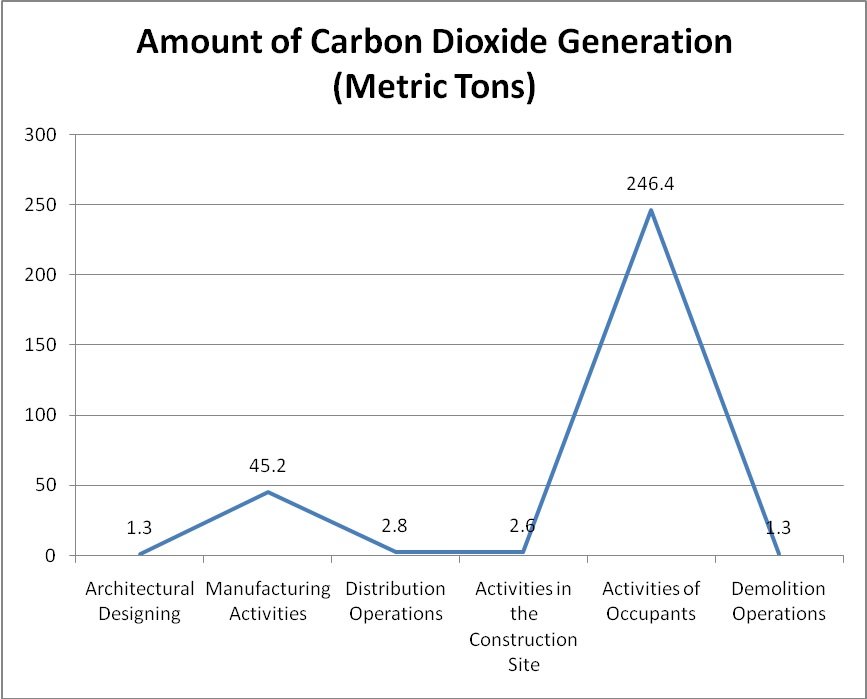
(BIS: Department for Business Innovation and Skills, 2010, pp.3-4)
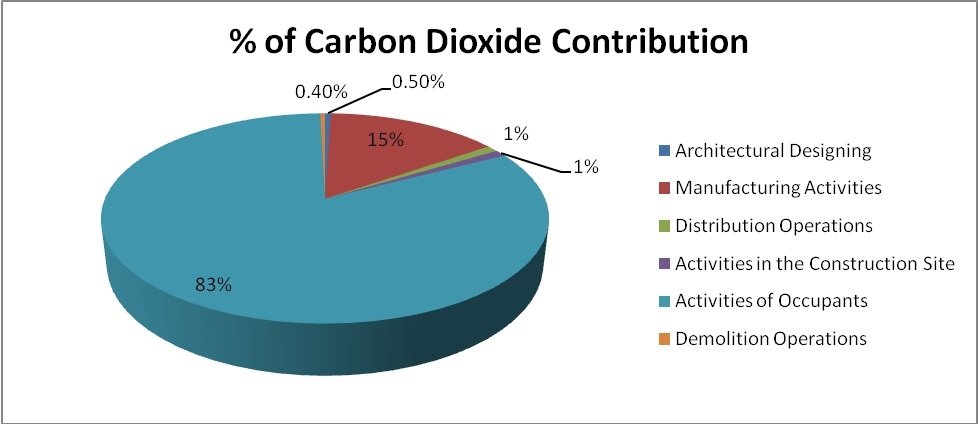
(BIS: Department for Business Innovation and Skills, 2010, pp.3-4)
The carbon dioxide generation in the architectural and designing section is computed based on the total number of employees taken in a sample multiplied with the average amount of carbon dioxide amount generated by them owing to travelling activities and use of fuel energy sources. The manufacturing activities of the construction sector include the manufacturing operations of allied sectors, which contribute in the production of materials for construction purposes. It includes both metallic and non-metallic products like chemical products viz. paints, minerals and other natural products like rubber and wood. These separate manufacturing operations contribute to the total carbon dioxide emissions of the manufacturing segment. The carbon dioxide emissions of these sections can be also tabulated as follows.
| Sub Sections of the Manufacturing Operations | Amount of Carbon Dioxide generation (Metric Tons) |
| Manufacture of Wood Products | 1.9 |
| Manufacture of Paints | 0.2 |
| Manufacture of Rubber Products | 0.8 |
| Manufacture of Plastics | 3 |
| Manufacturing Glass Products | 1.4 |
| Cement and Clay Manufactures | 11.6 |
| Concrete Products | 1.2 |
| Metal and Alloy Products | 2.2 |
| Iron and Steel Products and other Manufacturing Castings | 7.1 |
| Import Operations of Construction Commodities | 15.8 |
(BIS: Department for Business Innovation and Skills, 2010, pp.5-6)
The above information can also be represented graphically as follows.
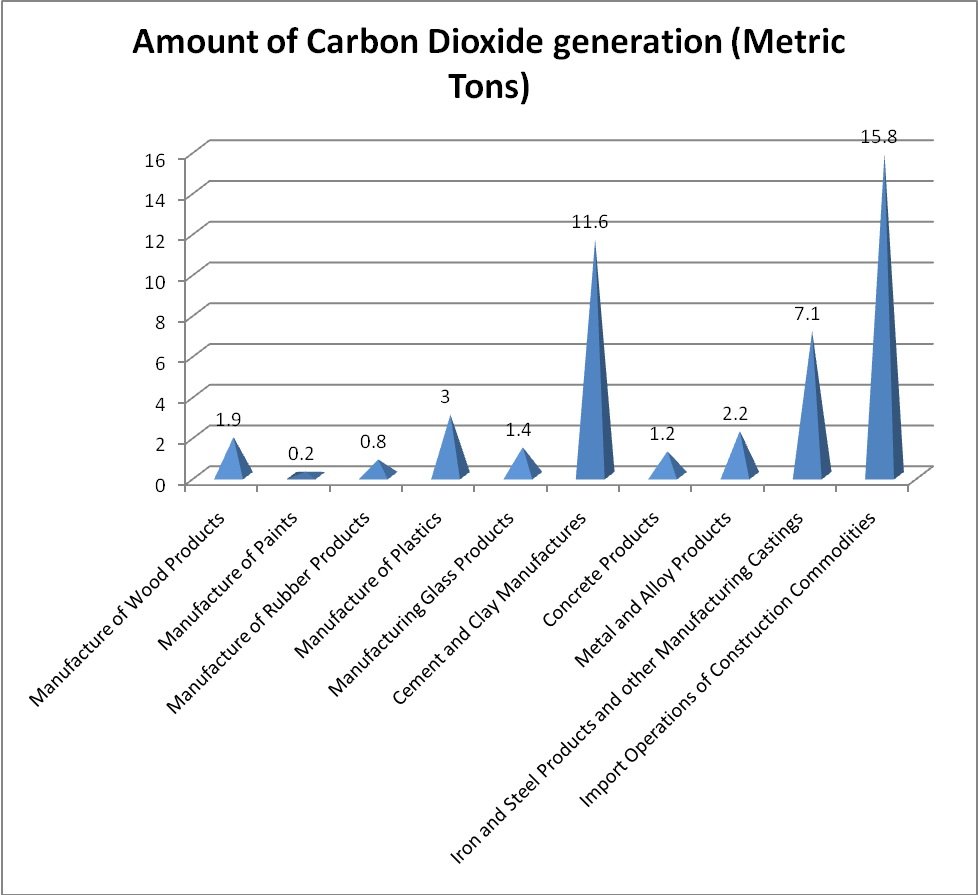
(BIS: Department for Business Innovation and Skills, 2010, pp.5-6)
A Pie Chart is given to reflect the contribution of the different sections of the manufacturing operations in the emission of carbon dioxide.

(BIS: Department for Business Innovation and Skills, 2010, pp.5-6)
The graph shows that apart from the import of construction commodities the production of concrete and cement and clay manufacturing operations in the construction industry amount to the highest amount of carbon dioxide emissions in United Kingdom. The production of iron and steel products along with metal castings rank the third in helping the manufacturing operations in construction industry to amount to 45.2 metric tons of carbon dioxide emissions which is 15 percent to the total amount of such emissions in the industry. Similarly the distribution activities of the construction industry which amounts to 1 percent of the total carbon dioxide generation by the industry can be divided along two parts viz. the freight services used for transportation of construction materials and other travelling activities for business purposes. Out of the two types of transportation activities the Freight services used amount to 1.9 Metric tons of Carbon Dioxide while travelling activities for business operations amount to only 0.9 Metric Tons. The data can also be represented in tabular and graphical form as follows.
| Distribution Activities of the Construction Industry | Amount of Carbon Dioxide Emissions (Metric Tons) |
| Freight services used for transportation of construction materials | 1.9 |
| Other travelling activities for business purposes | 0.9 |
(BIS: Department for Business Innovation and Skills, 2010, p.6)
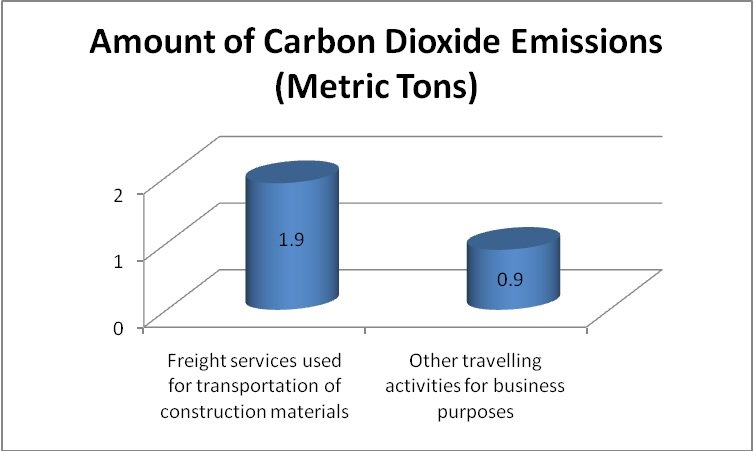
(BIS: Department for Business Innovation and Skills, 2010, p.6)
The activities pertaining to the construction sites also both on site and off site which also amount to 1 percent of the total carbon dioxide generation of the construction industry can be divided essentially into three parts. Apart from on site operations the off site operations of the construction industries consist of both assembling operations and other official works which also amount to carbon dioxide emissions. The amount of carbon dioxide emissions of the construction site activities can be represented in the form of tables and graphs as follws.
| Construction Site Activities | Amount of Carbon Dioxide Emissions (Metric Tons) |
| On-Site Activities | 2 |
| Assembly Operations | 0.3 |
| Official Operations | 0.3 |
(BIS: Department for Business Innovation and Skills, 2010, p.6)
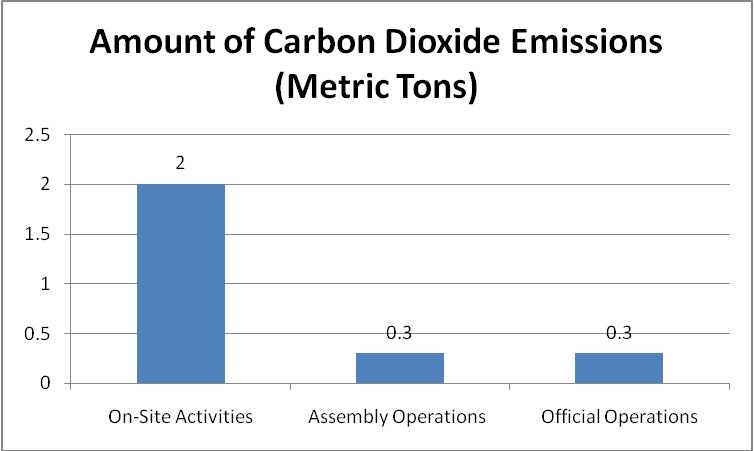
(BIS: Department for Business Innovation and Skills, 2010, pp.5-6)
The activities of the occupants of the manufactured buldings which consist of both residential and commercial properties consitute about 83 percent of the total amount of carbon dioxiode generated by the construction activities in United Kingdom. It is found that in the total amount of carbon dioxide emissions by the occupants amounting to 246.4 metric tons of carbon diooxide the residential properties amount to 145.7 metric tons of carbon dioxide. While computing the amount of carbon dioxiode emissions by the non-residential and commercial properties the emissions during construction and design of buildings is deducted. The data can also be reprsented in tabular and graphical fashion as follows.
| Occupants Activities Amounting to Carbon Dioxide Emissions | Amount of Carbon Dioxide Emissions (Metric Tons) |
| Residential Properties | 145.7 |
| Non-Residential Properties | 100.7 |
(BIS: Department for Business Innovation and Skills, 2010, p.7)
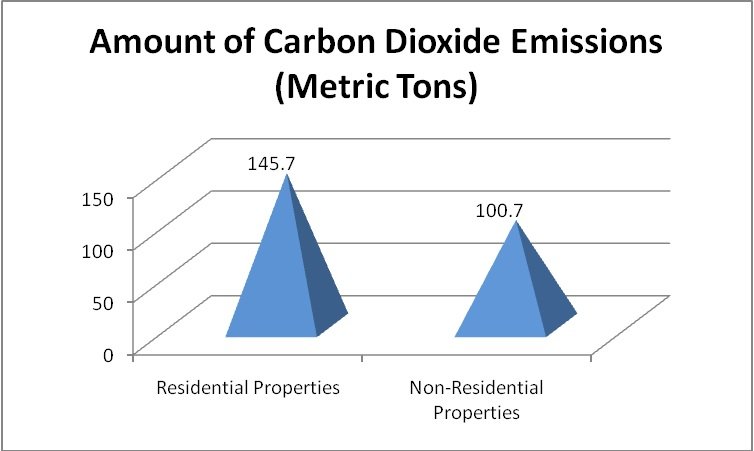
(BIS: Department for Business Innovation and Skills, 2010, p.7)
A pie chart is also given to reflect the percentage contribution of the two sectors in generating around 83 percent of the total carbon dioxide generation by the total construction industry.
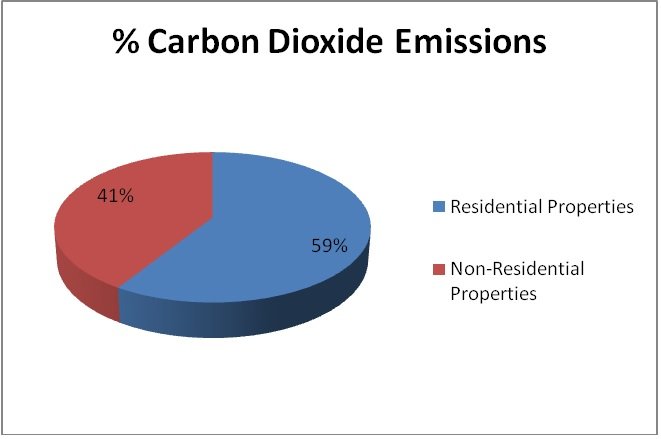
(BIS: Department for Business Innovation and Skills, 2010, p.7)
Like the architectural designing operations the demolition activities in United Kingdom also contribute to a small fraction to the total carbon dioxide emissions in the construction industry in United Kingdom. The 0.4 percent contribution of the demolition activities in carbon dioxide emissions can be further subdivided into two parts viz. maintainance activities and other waste removal operations. The amount of carbon dioxide emitted by the two activities can be represented through tables and graphs as follows.
| Demolition Activities | Amount of Carbon Dioxide Emissions (Metric Tons) |
| Maintenance Activities | 0.7 |
| Waste Removal Operations | 0.6 |
(BIS: Department for Business Innovation and Skills, 2010, p.7)

(BIS: Department for Business Innovation and Skills, 2010, p.7)
Another set of findings compare the amount of carbon dioxide emissions from the construction and use of buildings in an overall manner pertaining to the regions of United Kingdom and Sweden. The findings made state that around 52 percent and 20 percent of the total carbon dioxide emissions in both United Kingdom and Sweden respectively is made by the stream of construction activities (Joint UK-Sweden Initiative on Sustainable Construction, 2006). The above data can also be represented through graphical presentation as follows.

(Joint UK-Sweden Initiative on Sustainable Construction, 2006)
Apart from the emissions of large volumes of Carbon Dioxide gases the construction industry is also characterized by the consumption of huge amounts of energy thus rendering an impact on the natural environment. The cement industry as a major part of the construction industry is found to render huge support to the government’s actions for the promotion of renewable energy sources. The cement industry invests to a large extent for the adoption of renewable energy sources in its operations and also to the major innovations in this field. Thus the amount of energy consumption in the cement industry is found to decline from the period of 1990 to 2006. During 1990, the energy consumption per ton of cement stood at 1680 Kilo Watt hour, which came down to around 1220, Kilo Watt Hour per ton of cement produced during 2006. The above findings can be graphically represented as follows. (Great Britain: Parliament: House of Commons: Environment Audit Committee, 2008, pp.34-35). The graph shows the declining trend of the cement industry in United Kingdom in using the energy sources for its operations.
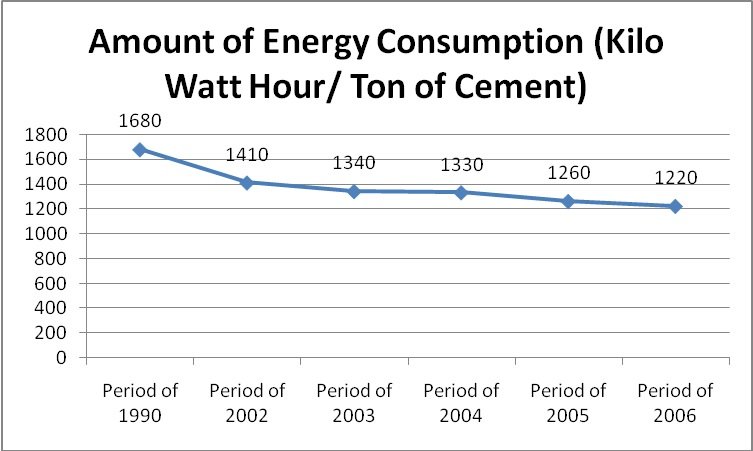
(Great Britain: Parliament: House of Commons: Environment Audit Committee, 2008, pp.34-35)
The environmental management systems in action to create sustainable environmental practices in the construction industries in United Kingdom are a number of policy measures like the International Standards Organization 14000 series and Quality Management measures relating to environment. These environmental management systems render some impacts in changing the operational processes and procedures of the construction industries to make them environmentally sustainable. The findings show the response rate of the construction companies in adopting the International Standards Organization 9001 and 14001 series. Around 40 percent of the construction companies have adopted the ISO 9001 Series while only 3 percent adopted the ISO 14001 Series. Again around 37 percent of the construction companies have employed the ISO 9001 Series for addressing key issues while only 7 percent of them have used the ISO 14001 Series for such actions. These findings show that the construction companies in United Kingdom feel more conscious about quality management issues than caring for the environment as per the ISO 14001 guidelines (Cobra 2008, 2008, p.7). The above findings can be graphically represented as follows.

(Cobra, 2008, p.7)
The ISO 14001 is observed to confer some distinct adavantages to those companies which have adopted its guidelines into their management operations. A number of factors like rendering economic eficiency to the companies, satisfying the customers, gaining larger market share and performance evaluation were strongly adressed by the implementation of the ISO 14001 Standard (Cobra, 2008, p.7). A tabular and graphical representation of such parameters being addressed owing to ISO 14001 implementaion is presented herwewith.
| Parameters | % of Benefits Received on implementation of ISO 14001 |
| Economic Efficiency | 57% |
| Satisfying Customers | 43% |
| Increase in Market Share | 23% |
| Enhancing Efficiency | 23% |
| Enhancing Competitive Position | 20% |
| Growth in Profits | 7% |
| Helping in Evaluating Performance Standards | 50% |
(Cobra, 2008, p.7)
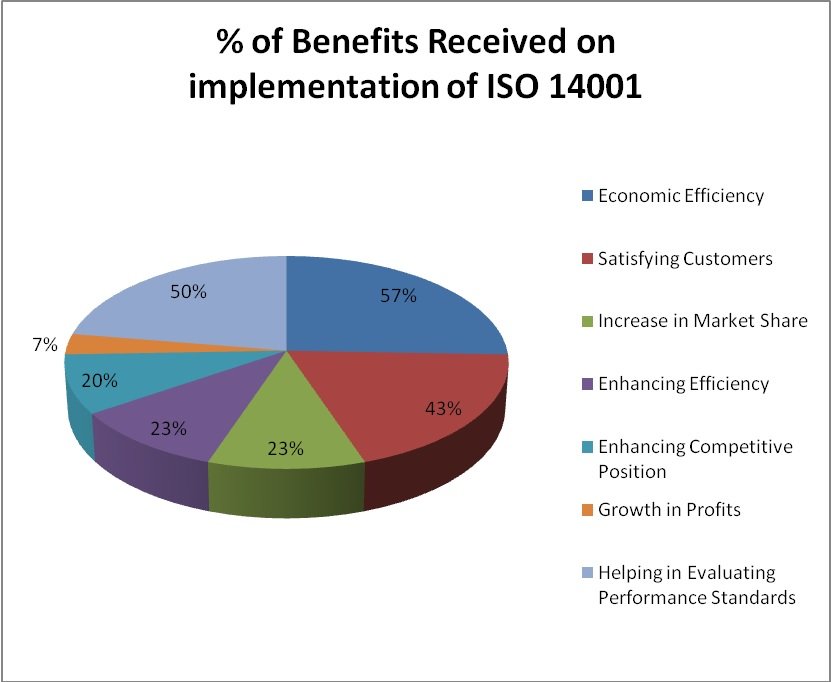
(Cobra, 2008, p.7)
Discussion
The construction industry in United Kingdom in the light of the carbon emissions from its various sectors focuses on certain activities to reduce the level of carbon emissions from the several companies. The construction developers in the region are endeavoring to develop buildings that would emit less carbon dioxide gas in the environment. Further the suppliers of materials to construction companies are being monitored to render low carbon generation products to them. Moreover the designers are also focusing to construct buildings, which would render energy efficiency to the economy and thus reduce the impact on natural energy sources. The construction companies are increasingly pursuing practice of using renewable energy sources like the solar energy. The construction industry desires to reduce the Carbon Dioxide content by around 35 percent by the close of 2020 than what it was during 2005. Estimates made show that the country would be economically benefitted by around 4 billion pounds. (Low Carbon Construction: Innovation and Growth Team, 2010, pp.12-13, 35).
The construction companies in United Kingdom are focusing on a number of measures to reduce the waste content emanating out from its operational processes. The construction industries are looking forward to use recyclable materials to reduce the contents of waste generated at the operation sites. The construction industries of United Kingdom are also stressing to incorporate the system of best practices to gauge the short and long term impacts on the natural environment owing to such. The companies also started collecting large amounts of data pertaining to waste piling to improve organizational consciousness of minimization of such. (Construction Waste Minimization in Housing, n.d., p.2).
In addition to the above measures the construction industries of United Kingdom are also endeavoring to adopt other means to reduce its impacts in causing environment pollution. The construction industries are trying to start construction projects on non-arable lands thus protecting the natural vegetation. Further the construction industries in order to reduce the flow of dust are endeavoring to use water sprays to dampen its spreading. The vehicles carrying construction dust and other materials are being properly covered and sprayed with water to prevent pollution. The construction industry is also endeavoring to use environmentally safer chemicals and paints for construction uses to reduce the intensity of hazards. Further these chemical substances along with the drainage systems in the site are properly covered from contaminating the atmosphere. The fuel used for the transportation vehicles are made sulfur free to reduce the spreading of harmful gases into the atmosphere. Construction companies are also reducing the activities like igniting waste materials, as it becomes the potential source of carbon dioxide emissions. The use of sophisticated construction tools are also widely encouraged which are innovated as such to reduce the spread of noise emanating from construction industries (Pollution from Construction, n.d.).
The government of United Kingdom strongly recognizes the importance of possessing an environmental management system in place for all the organizations of the country in whatever category it belongs to. It is because it has been increasingly observed that the environmental management systems like ISO 14001 Series helps a company in enhancing its profitability and market share. Such programs develop the company’s accountability to the society and thus better up its relationship with its customers. This fact helps in enhancing the growth of brand image of the company and thereby helps in motivating the employees to work in a better way. However it is observed that the implementation of ISO 14001 standards in the construction industries constitutes to be an arduous task for the temporary features of their on-site operations. (Construction industry urged to adopt environmental management systems, 2000).
The urge made to the construction industries in United Kingdom to take resort to ISO 14001 measures owing to a number of operational and transaction benefits. Adapting to such programs helps the company in meeting legislative and regulatory objectives. Further such measures help in enhancing organizational competitiveness through creating a better brand image. Such measures also help the company in evaluating its performance standards while meeting environmental goals. It also helps the concern to reap the benefits of several financial and insurance schemes. The company in gaining the potency in meeting social goals gains a leadership position in the country. (A Six-Month Strategy for the Construction Industry: Implementing ISO 14001, n.d.).
Conclusion
The construction industry in the United Kingdom occupies a place of pride in generating revenue for the country and in rendering large number of employment opportunities. With the rise in demand for better and more number of houses the activity of the construction companies have also increased from the past. The construction companies of United Kingdom are resorting to large number of products for operation purposes, which can be increasingly obtained from the natural environment. Even the construction companies of United Kingdom are procuring such products from countries like Germany and Netherlands, which have less of legislative hazards regarding the import of natural materials. The construction companies of the region have also become the potential contributors to the spread of greenhouse gases like Carbon Dioxide in the atmosphere. Further such companies are also characterized making large number of waste products, which become piled up, in the open atmosphere. These piled up waste products become the source of further environmental pollution. Dusts accumulating from construction sites increasingly spread along the region and cause severe health problems like breathing ailments. Moreover the spread of dust along the road surfaces also damage the aesthetic value of the region for the creation of mud layers with the start of the rains. This factor also contributes to the increasing of accidents thereof. The construction activities of the region are also being observed to focus on the cutting down of large amount of trees around the region and taking over vegetable lands for their operations. These activities thus render potential economic and social impacts in disturbing the ecological balance of the region. Owing to the felling of large number of trees in the region the construction activities contribute in reducing the habitat regions of the country leading to a loss of biodiversity. Many known and unknown species disappear from the planet’s face owing to the activities of the construction sector. Further the deafening noise produced by the use of heavy machinery also disturbs the comfort of the people residing nearby leading to sleep disorders and deafening of the employees working in. Thus the construction industries of developed regions like United Kingdom are increasingly taking resort to the use of sophisticated machineries, which would help in reducing the noise emanating from such. Further the construction companies are also taking resort to the spraying of water over the dust particles to help protect them from spreading over to help reduce pollution. Sulfur free fuels to reduce the intensity of air pollution are feeding the vehicles used for transportation of construction goods. The environmental management systems like International Organization Standards 14001 Series are being increasingly pursued by large number of companies to render a friendly face to the society. These environmental standards help the companies to become increasingly socially accountable which helps in enhancing its brand image in front of the society and large group of stakeholders. Further incorporation of such also helps in motivating the employees to work in a motivating manner, which thereby helps in increasing the profits and market share of the companies. Further the environmental management systems render a ‘life cycle approach’, which helps the companies to evaluate the performance of their organizations in the light of meeting the environmental goals. However in the context of the construction industries it is observed that incorporation of such environmental management systems counter some definite problems. The construction industries mainly operate based on open sites, which are highly temporary in nature. Thus the management of such systems through proper implementation becomes a problem. Further the products of the construction industries involve the construction of large number of buildings, which have large number of people coming from different social and cultural groups. Thus implementation of the environmental management systems in regards to construction industries involve the management of the social and cultural backgrounds of the people which itself becomes an arduous task. Further these localities keep on increasingly changing from time to time thus demanding further scrutiny in the implementation of such programs.
References:
- “Environmental Impact “, (2010), natural-building.co.uk , Available at <http://www.natural-building.co.uk/environmental_impact.html> (accessed on February 27, 2011).
- Selih, J. (n.d.), Environmental Management Systems in the Construction Industry, Available at<http://huog.hr/sedma/PROCEEDINGS%20IN%20PDF/Selih.pdf> (accessed on February 27, 2011).
- Federation Internationale du beton (2008), Environmental design of concrete structures – general principles: technical report prepared by a working party of Task Group 3.6, FIB – Féd. Int. du Béton.
- Sarsby, R. (2000), Environmental geotechnics, Thomas Telford.
- Couto, J. & A. Couto (2007), Construction sites environment management: estabilishing measures to mitigate the noise and waste impact, Portugal SB07 Sustainable Construction, Materials and Practices: Challenge of the Industry for the New Millennium, IOS Press.
- Australian Bureau of Statistics (2005), Yearbook, Australia, Issue 87, Aust. Bureau of Statistics.
- Holt, A. (2005), Principles of construction safety, Wiley-Blackwell
- Fox, W. (2000), Ethics and the built environment, Routledge,
- Langford, D. & A. Retik (1997), Organization and Management of Construction: Managing Construction Information, Taylor & Francis
- Fryer, B., Fryer, M, Egbu, C. & R. Ellis (2004), The practice of construction management:people and business performance, Wiley-Blackwell
- Ball, J. (2002), Can ISO 14000 and eco-labelling turn the construction industry green?, Building and Environment , Vol. 37, pp. 421 – 428, Available at: <http://bmb.cu.edu.tr/evlac/_private/Documents/Literature%20review%20links/ISO%2014000.pdf> (accessed on February 27, 2011)
- Jugenheimer, D., Bradley, S., Kelley, L. & J. Hudson. (2010). Advertising and Public Relations Research. M.E. Sharpe.
- “Primary Research-Disadvantages”, (n.d.), Available at <http://www.knowthis.com/principles-of-marketing-tutorials/data-collection-primary-research-methods/primary-research-disadvantages/> (accessed on February 27, 2011)
- Gillham, B. (2000), Case study research methods, Continuum International Publishing Group.
- Cohen, L., Manion, L., Morrison, K., & K. Morrison (2007), Research methods in education, New York: Routledge.
- BIS: Department for Business Innovation and Skills (2010), “Estimating the amount of CO2 Emissions that the Construction Industry can Influence”, Available at <http://www.bis.gov.uk/assets/biscore/business-sectors/docs/e/10-1316-estimating-co2-emissions-supporting-low-carbon-igt-report> (accessed on February 27, 2011)
- “Joint UK-Sweden Initiative on Sustainable Construction “ (2006), ukswedensustainability.org , Available at <http://www.ukswedensustainability.org/bestpractice/bestpractice01.jsp> (accessed on February 27, 2011)
- Great Britain: Parliament: House of Commons: Environment Audit Committee (2008), Reducing carbon emissions from UK business: the role of the climate change levy and agreements, second report of session 2007-08, report, together with formal minutes, oral and written evidence, The Stationery Office
- “Cobra 2008” (2008), rics.org, Available at < http://www.rics.org/site/download_feed.aspx?fileID=3197&fileExtension=PDF> (accessed on February 27, 2011)
- “Low Carbon Construction: Innovation and Growth Team “ (2010), berr.gov.uk , Available at < http://www.berr.gov.uk/assets/biscore/business-sectors/docs/l/10-671-low-carbon-construction-igt-emerging-findings.pdf> (accessed on February 27, 2011)
- “Construction Waste Minimization in Housing “ (n.d.), cardiff.ac.uk , Available at <http://www.cardiff.ac.uk/archi/programmes/cost8/case/waste/uk-waster.pdf> (accessed on February 27, 2011)
- “Pollution from Construction “ (n.d.), sustainablebuild.co.uk , Available at <http://www.sustainablebuild.co.uk/PollutionFromConstruction.html> (accessed on February 27, 2011)
- “Construction industry urged to adopt environmental management systems “ (2000), edie.net , Available at <http://www.edie.net/news/news_story.asp?id=2564&channel=0&title=Construction+industry+urged+to+adopt+environmental+management+systems> (accessed on February 27, 2011)
- “A Six Month Strategy for the Construction Industry: Implementing ISO 14001” (n.d.), ccinw.com, Available at < https://www.ccinw.com/images/publications/FT-14%20brochure.pdf> (accessed on February 27, 2011)
